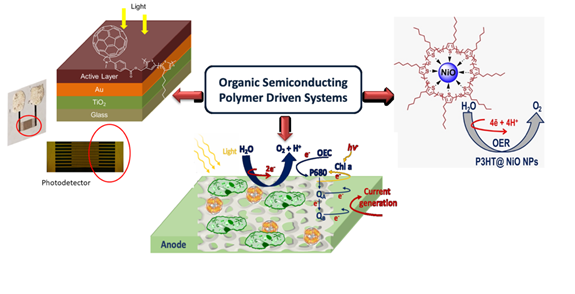
Electron Donor Acceptor Double Cable Covalent Conjugates: Towards Improved Photovoltaic Devices and Accelerated Artificial Photosynthesis
Abstract
Tremendous amount of effort is being invested in improving the optical and electrical properties of semiconducting materials for application in diverse technologies such as photovoltaics, photocells, battery electrodes, thin-film transistors, interfacing electrodes, functional surface coatings, and biosensing devices. These efforts have led to a remarkable development in the field of semiconducting materials offering versatile chemical and functional traits. In this context, various chemically and functionally distinct classes of organic semiconducting polymers (OSPs) have been developed as alternatives to inorganic semiconductors. Compared to their inorganic counterparts, OSPs are easy to synthesize and present possibilities of installing chemically diverse functional groups on the semiconducting polymer molecules as side chains and end groups. These provisions have resulted in the development of a toolbox of OSPs with tunable optical and chemical properties that can be customized for a target application. In quest of expanding the advantages offered by OSPs and in pursuit of novel OSPs with unique chemical, optical and electronic properties, current thesis is focused on the development of side chain engineered polythiophene OSP for application in energy, environment, and biomedical domains. The synthesis of polythiophene OSPs was accomplished through Grignard Metathesis (GRIM) polymerization. GRIM polymerization offers a chain growth type of mechanism for the synthesis of regioregular polythiophene OSP with a possibility of controlling side and end groups of the resulting polythiophene molecules.
The functional groups installed on the OSP molecules as side or end groups can be transformed into other desired functional groups via facile post-synthetic modifications. The OSPs with the suitable functional groups installed on them can have a better integration with other components of the functional systems for effectively augmenting a range of applications. The overarching aim of this research was to develop a variety of OSPs with controlled chemical nature and density of side chain functional groups. The resulting side chain engineered OSPs were employed to develop functional materials for energy, environmental, and biological applications. In context of energy applications, a part of this thesis work is related to developing facile strategies for covalent conjugation of OSPs as electron donors (D) with a range of electron acceptors (A) for a better electronic communication between D-A construct for enhanced photovoltaic effect. The primary focus, in terms of electron acceptors, is on graphitic carbon nanomaterials such as fullerenes. In this context, an unprecedented conjugation strategy was developed that can be applied directly on the pristine graphitic carbon nanomaterials without the need of any pretreatment.
The insight into the efficacies of electronic communication in the developed D-A covalent hybrid systems was revealed through current generation in photodetector devices fabricated from the developed D-A covalent hybrids. The developed D-A conjugation strategies will open new avenues to materials with tunable electronic communications. The controlled molecular design of OSPs and resulting materials will help in advancing the applications that are based on photovoltaic effect. Besides developing D-A covalent hybrids of OSPs and graphitic carbon nanomaterials, the OSPs developed in this study were applied in the development of hybrids of OSPs and electrocatalytic nanoparticles (NPs) to synergize their distinct optical and electrical properties. Within this domain, heteroatom containing poly(3-hexylthiophene) P3HT was employed as a stabilizing agent to develop size-controlled NiO NPs for application in (electro)catalysis. In addition, novel light harvesting NPs systems based on covalent conjugation of OSPs with flavin moieties are developed that can be employed in Biophotovoltaic (BPV) devices to mimic natural photosynthesis. For proof of concept, cyanobacteria were embedded in a synthetic biofilm containing polythiophene/flavin NPs to improve the light-harvesting ability of cyanobacteria and enhancement of the extracellular electron transfer from cells to electrodes for improved electricity generation in BPV devices.
The outcomes of this effort will help in finding alternative solutions for transformation of solar energy to chemical energy (e.g., conversion of CO2 to chemicals or H2 production) as well as biophotoelectricity generation. In summary, this work has produced new side chain engineered OSPs and their hybrids with a unique molecular design suitable for the fabrication of a variety of functional semiconductor systems for energy, environmental, and biological applications.
Final Defense Committee (FDC):
- Dr. Muhammad Abdullah Khan, Department of Chemistry, QAU (External Examiner)
- Dr. Ammar Ahmed Khan, Department of Physics, LUMS (Internal Examiner)
- Prof. Dr. Irshad Hussain, Department of Chemistry and Chemical Engineering, LUMS (Thesis Committee Member)
- Dr. Salman Noshear Arshad, Department of Chemistry and Chemical Engineering, LUMS (Thesis Committee Member)
- Dr. Nauman Zafar Butt, Department of Electrical Engineering, LUMS (Thesis Committee Member)
- Dr. Basit Yameen, Department of Chemistry and Chemical Engineering, LUMS (Supervisor)
List of Publications:
- Iftikhar, S.; Aslam, S.; Duran, H.; Çitoğlu, S.; Kirchhoff, K.; Lieberwirth, I.; Yameen, B.; Poly(3-hexylthiophene) Stabilized Ultrafine Nickel Oxide Nanoparticles as Superior Electrocatalyst for Oxygen Evolution Reaction: Catalyst Design through Synergistic Combination of p-Conjugated Polymers and metal-based Nanoparticles, J. Appl. Poly. Sci, 2022, e52636.
- Iftikhar, S.; Aslam, S.; Butt, N. Z.; Ashraf, R. S.; Yameen, B.; Prato reaction derived polythiophene/C60 donor–acceptor double cable polymer, fabrication of photodetectors and evaluation of photocurrent generation, J. Mater. Chem. C, 2020, 8, 17365.
- Arshad, A.; Irfan, H.; Iftikhar, S.; Yameen, B.; Conductive Polymers for Cardiovascular Applications, Nanoscale Engineering of Biomaterials; Properties and Applications, Springer, 2022, pp. 319-347.
- Iftikhar, S.; Ahmed, I.; Del Cairo Di Prunetto, A. S.; Parshad B.; Howe, C.; Yameen, B.; Fruk, L.; Polythiophene-flavin double cable polymer nanoparticles for light harvesting activity enhancement in cyanobacteria. (Manuscript in preparation)

